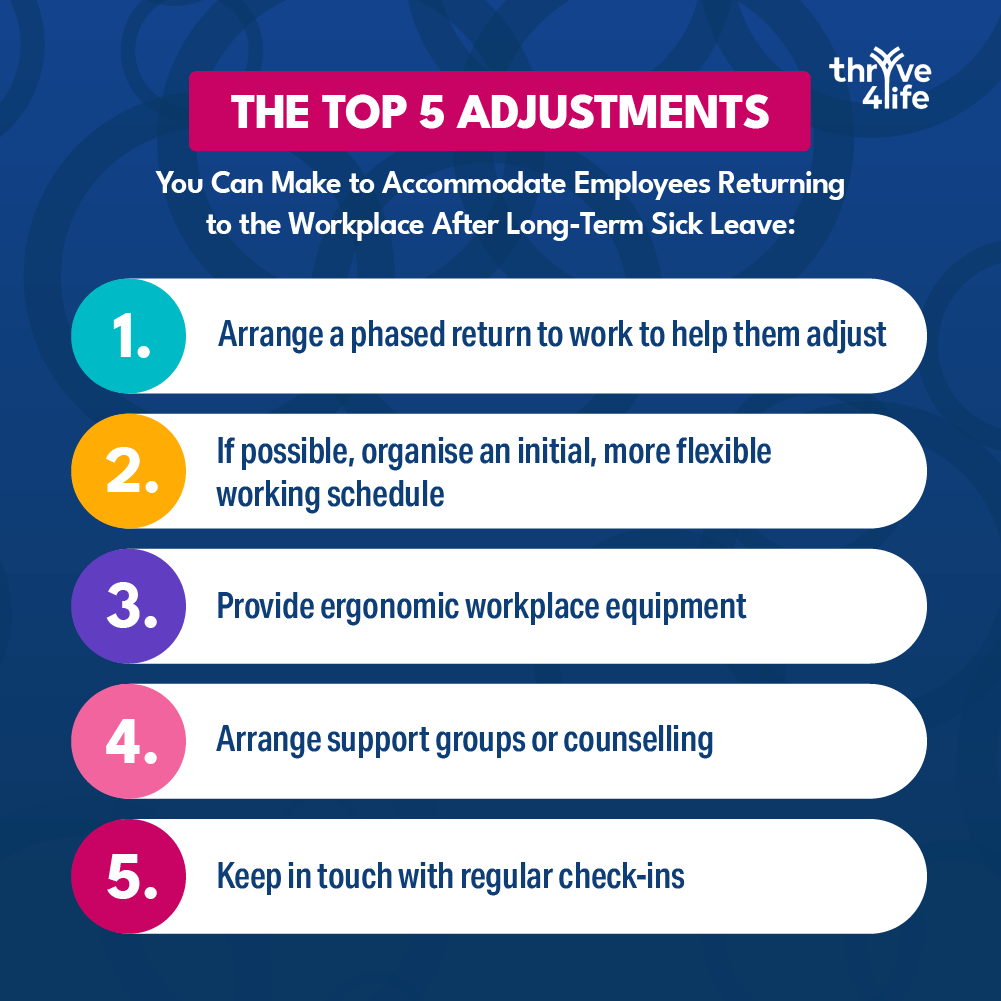Having an employee back at work after an extended period of sickness absence is always a relief. However, it is often unrealistic to assume that they will seamlessly transition back into work responsibilities without any challenges or adjustment period. The employee might still be dealing with compromised health, harbouring concerns about their ability to keep up with tasks, and having to manage their own ongoing rehabilitation plan. Line managers should recognise these challenges and approach their team member’s return to work with empathy, compassion, and a willingness to make reasonable adjustments that satisfy both employee and employer.
In the thirteenth and final instalment of our line management blog post series, we’re exploring the factors line managers should consider when welcoming employees back from sickness, uncovering the importance of reasonable adjustments, and highlighting the positive impact these accommodations can have on employee wellbeing.
You’re reading a blog post from our Line Management series
Below are links to all the posts in this series:
Ensuring Smooth Transitions: The Importance of Helping Employees Readjust to Work
A smooth transition back to work can significantly benefit these 4 Key Areas:
- Employee Health and Morale: A supported readjustment to working life can make employees feel more confident and mitigate any work-related stress or anxiety. By committing to effective transitions for employees and focusing on how they can implement wellbeing-boosting measures to support their whole team, line managers can support returning employees’ morale and prevent them from relapsing into poor mental and/or physical health.
- Increased Productivity: By helping employees overcome the challenges of returning to work after poor health, line managers can help boost organisational productivity and performance. Employees who feel confident in their ability to keep up with tasks and meet targets will inevitably produce higher-quality work, helping to make the entire business more productive and efficient.
- Reduced Absenteeism: By supporting employee health and recovery from illness at work, line managers can reduce sickness-related absenteeism (habitual absence from work). Absenteeism differs from formal sickness leave as it takes place without warning and can frequently disrupt regular working schedules. According to Public Health England, sickness-related absenteeism costs UK businesses up to £100 billion annually.₁
- Reduced Employee Turnover: When employees are supported to readjust to workplace routines without compromising their wellbeing, they are less likely to resign for health reasons. By minimising health-related resignations, businesses can reduce the financial costs and time losses associated with high staff turnover. Research conducted by Oxford Economics reveals that each departing employee can cost UK businesses an average of £30,614.
By taking steps to facilitate an employee’s transition back to the workplace after a period of poor mental and/or physical health, line managers can improve the employee’s levels of engagement, helping them feel more connected and committed to their role and the wider organisation. These measures can also boost staff retention and help prevent substantial financial losses for the business.
Developing a Return-to-Work Plan: The 3 Key Principles
At Thrive4Life, we suggest line managers focus on the following 3 Principles when developing a return-to-work plan:
- Clear Communication: A return-to-work plan should be developed in a dedicated return-to-work meeting. During this meeting, both the line manager and the employee’s concerns and questions should be addressed. The line manager must also inform the returning employee of any expectations they have going forward, allowing the employee the opportunity to honestly communicate which roles and responsibilities they feel they can or cannot cope with once they return to work. Line managers should update employees on their team’s progress and current projects so they do not feel out of the loop when they return.
- Collaboration: When devising a return-to-work plan, the line manager and the employee should engage in a process of collaborative goal-setting. Taking this collaborative approach and discussing the employees’ preferences and limitations, line managers should also be better equipped to balance returning employees’ workloads. This approach will help managers assign goals and tasks that consider the employee’s recovery and adjustment needs.
- Flexibility: Line managers must be receptive to adjusting or modifying the return-to-work plan when needed. Recovery from illness is often far from linear, and there is no way to align an employee’s exact health circumstances along work timelines. This means that where possible, line managers should make the return-to-work plan flexible by being open to remote working options, readjusting workloads, and even reassigning tasks when necessary. Flexibility ensures that line managers and employees are both able to review the plan and make adjustments in line with the affected employee’s changing health and wellbeing needs.
Clear and honest conversations with employees can help line managers develop a roadmap that anticipates challenges, outlines the steps to address these challenges, and promotes employee wellbeing. By encouraging open dialogue and continuing to seek employee feedback, line managers can use the return-to-work plan to cater for their team members’ health and wellbeing by offering reasonable adjustments that support them without compromising their team’s productivity
Reasonable Adjustments: Guidelines and Frameworks

When line managers are formulating reasonable adjustments before their return to work, there are two essential considerations they should have in mind: the returning employee’s individual health requirements and their ability to perform in their respective role. To ensure optimal business performance, any reasonable adjustments line managers offer must safeguard employee health while upholding organisational success. What adjustments can line managers make to accommodate employees returning to the workplace? Here are our Top 5 recommendations:
1. Phased Return To Work: By gradually reintegrating the employee back into the workplace, the line manager can give them the time and space needed to fully recover from illness or injury and regain their health. The line manager could consider increasing the employee’s workload and responsibilities incrementally (over a set period) to gradually ease their transition back to full productivity.
2. Flexible Work Schedule: Where possible, line managers should try to offer flexible hours or working options for employees returning from sickness leave. For example, they could offer hybrid working options to reduce long commuting times or readjust returning employees’ working hours to allow them to attend medical appointments or therapy/counselling sessions.
3. Ergonomic Equipment: The line manager should ensure that the layout and set-up of their team members’ workstations align with best ergonomic practices. This will help employees avoid musculoskeletal pain and discomfort – especially important if this was the reason for a returning employee’s absence in the first place. If based in an office, line managers should work with their employer to ensure the office’s furniture is ergonomically set-up and supportive of employee musculoskeletal health. This might include office chairs with lumbar support and adjustable armrests or computer stations with adjustable heights to help employees maintain proper posture and reduce neck and eye strain. At Thrive4Life, we offer a range of injury prevention services, including one-to-one DSE workstation assessments (both in-person and online). These services can give line managers the chance to consult highly-experienced physiotherapists and osteopaths who can provide advice and training on workstation/DSE-related issues.₂
4. Support Groups and Counselling: Support groups can be invaluable in helping employees readjust to the workplace. These groups can serve as safe spaces where returning employees can discuss any anxieties or worries and seek guidance from colleagues who have experienced (or are currently experiencing) similar physical or mental health issues. To provide further guidance and professional insights, line managers could also arrange for mental health professionals to come into their workplace and speak with employees who may be struggling.
5. Regular Check-Ins: This may seem straightforward, but you should never underestimate the power of a quick check in. A simple 1:1 chat with returning employees can help boost their morale and improve their engagement in the workplace. To keep things relaxed, line managers could schedule 5-10-minute informal chats with returning employees over a cup of coffee. These meetings will allow the space to air and discuss any difficulties or challenges the returning employee might be facing. These check-ins will give the line manager a clearer picture of how well the employee is coping, enabling them to provide more specific support where needed.
The above suggestions provide line managers with a general overview of the support mechanisms they can employ to facilitate employee health and wellbeing. They’re not exhaustive and can, of course, be tailored towards organisational resources and the employees’ specific requirements.
The Equality Act 2010 legally mandates employers to offer reasonable adjustments to employees who are disabled or experiencing long-term physical and/or mental health conditions. To comply with these legal obligations, every organisation must offer reasonable adjustments in the case of disability or serious illness.₃
The Return-to-Work Toolkit: Thrive4Life’s Resources for Line Managers
Thrive4Life offers many useful services and resources that can help line managers facilitate their employees’ return after sickness absence. Here are our best recommendations:
● Wellbeing Consultancy: Our Wellbeing Consultancy services give line managers the opportunity to consult health and wellbeing professionals who can help them improve their health management strategies, address employee wellbeing needs, and implement the most effective support measures for their organisation. To find out more, you can book a free strategy consultation here.
● Line Management Training: This 90-minute training course equips line managers with the skills to manage employee stress levels and boost workplace mental wellbeing. Completing this training will help line managers learn how to spot poor employee mental health and take active measures to support struggling employees. This can be especially useful for employees recovering from mental health issues.
● Mental Health First Aid Course and Skills Development: Line managers can sign up for Thrive4Life’s Mental Health First Aid Course to become an MHFA-accredited Mental Health First Aider. The training and qualification gained can help line managers implement the best mental health strategies in the workplace, equipping them to become effective first-line resources of mental health support for their team members and colleagues.
After completing this initial course, line managers can then further refresh their mental health knowledge and top-up their skills with our Mental Health Skills Development Course, where they’ll also have the chance to consult professionals for organisation-specific mental health advice.
● Employee Health and Wellbeing Discovery Hub: Our Hub is an all-in-one resource for any health management needs. It contains a regularly updated and constantly expanding library of content which covers all kinds of health and wellbeing information, from guidance on specific physical and/or mental health concerns to advice on sleep, nutrition, exercise, and much more. This can be an especially useful resource when supporting a returning employee, as line managers can encourage these individuals to use the Hub to support their recovery further and improve their overall physical and mental health.
● Health and Wellbeing e-Content and Educational Wellbeing Talks and Webinars: In addition to our Hub, employers can also sign up for our monthly employee-facing e-Publications, which contain a vast range of educational health content on a variety of health and wellbeing topics.8 This content can help employees improve and support their physical and mental health and make lifestyle changes to keep them feeling healthy and happy – especially important if getting back on their feet again after a period of poor health.
Every month, we also hold live webinars and in-person talks led by leading medical specialists and consultants whose expertise sees us delving into a diverse range of areas of health and wellbeing.9 Previous talks include “Busting Stress Myths” led by burnout specialist Dr Amy Imms, “Musculoskeletal Health Management” hosted by physiotherapist Emma McDonalds, and “Heart Disease Prevention” brought to us by leading cardiologist Dr Guy Lloyd. Insightful and engaging, these talks can bring health and wellbeing to life for your team.
● Mini-Health Check – “Know Your Numbers”: Our one-to-one mini-health checks are simple, effective, and fuss-free. Taking place in the workplace and lasting just 15 minutes, employers can sign up for these checks to give employees a chance to gain a better awareness of their key health statistics, including blood sugar levels, BMI, and cholesterol. As key indicators of developing health issues, having a handle on these measures can give employees a better understanding of their overall health, giving them the opportunity to take action to improve certain aspects of their wellbeing before they start causing issues.
In Summary
Line managers can make all the difference when it comes to welcoming employees back to work after sickness leave. By prioritising employee health and wellbeing, they can develop flexible return-to-work plans and offer reasonable adjustments that create more positive working cultures where individuals feel valued, supported, and empowered to achieve their full potential. With planning, communication, and compassion, employees can successfully reintegrate into the workplace while supporting and upholding the organisation’s productivity levels. What could be better?
In this line management blog post series, we’ve taken a deep dive into the role of line managers in the workplace, looking at how their duties need to incorporate support for workplace health and wellbeing. We’ve explored how line managers play a crucial role in cultivating a healthy work culture, managing employee mental and physical health, supporting unwell employees during and after sickness leave, identifying the warning signs of poor health, and so much more. We hope these insights and frameworks can give line managers the power to transform their workplaces into thriving hubs of health and wellbeing where everyone feels supported to do their best.
From the first instalment to the thirteenth, we hope you enjoyed reading our line management blog post series, and stay tuned for more workplace health and wellbeing content every single week.
References & Further Reading
1. Health and Work Infographics. Public Health England.
2. The Cost of Brain Drain. Oxford Economics.
3. Equality Act 2010 Reasonable Adjustments. UK Gov.
https://www.gov.uk/reasonable-adjustments-for-disabled-workers
4. Wellbeing Consultancy. Thrive4Life.
https://www.thrive4life.co.uk/wellbeing-consultancy/
5. Line Management Training. Thrive4Life.
https://www.thrive4life.co.uk/health-wellbeing-training/line-management-training/
6. Mental Health First Aid Course. Thrive4Life.
https://www.thrive4life.co.uk/health-wellbeing-training/mental-health-first-aider-course/
7. Mental Health Skills Development. Thrive4Life.
8. Employee Wellbeing Hub. Thrive4Life.
https://www.thrive4life.co.uk/health-wellbeing-promotion/health-and-wellbeing-discovery-hub/
9. Health and Wellbeing ePublications. Thrive4Life.
https://www.thrive4life.co.uk/health-wellbeing-promotion/health-wellbeing-publications/
10. Educational Talks and Webinars Thrive4Life.
https://www.thrive4life.co.uk/health-wellbeing-promotion/talks-and-webinars/
11. Mini Health Check. Thrive4Life.
https://www.thrive4life.co.uk/health-wellbeing-promotion/employee-health-checks/
Further Reading:
12. Public Health England Infographics:
2. Oxford Economics Report:
https://www.oxfordeconomics.com/resource/the-cost-of-brain-drain/
3. Equality Act 2010:
https://www.gov.uk/reasonable-adjustments-for-disabled-workers
4. Lloyd’s Wellbeing Centre Blog: Caring for Your Mental and Emotional Wellbeing
https://www.lloydswellbeingcentre.co.uk/blog/caring-for-your-mental-and-emotional-wellbeing/
5. Lloyd’s Wellbeing Centre Blog: Kindess at Work
https://www.lloydswellbeingcentre.co.uk/blog/kindness-at-work/










